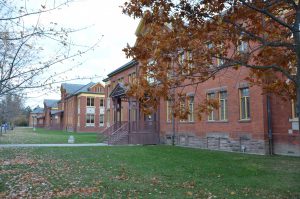The story of how Humber re-purposed the buildings from the Mimico Branch Asylum to create its Lakeshore Campus
Many students are unaware that the peaceful institution where they study, the Humber Lakeshore Campus, was once the Mimico State Asylum, a place where the city could segregate the “insane” from normal society.The first patients were a group of men from the Toronto Asylum who helped build the facility. They came in January 1890 to construct the asylum under the direction of chief architect, Kivas Tully. The construction was completed using unpaid patient labour.
Jennifer Bazar, tour guide of Tunnel Tours, a tour that gives a look inside the asylum, said the asylum “transferred patients all the time, if there was a good patient in Toronto and we started a construction project they would send them our way as a patient even though we needed him as a mason or a gardener.”
According to case reports about the asylum, it is clear that Mimico had the best treatment in the province, but some treatments were barbaric by modern standards.
Lakeshore Interpretive Ground’s website, said that in the early days, doctors used “moral treatment” which involved giving patients a regimented life, including employment. Men would have outdoor jobs at the slaughterhouse and gardening, while women would work indoors on tasks like laundry.
Doctors experimented with hydrotherapy which was a continuous bath, where they put patients in a tub filled with water. The patient’s head would be completely submerged in the water. Somatic therapy, such as electroshock therapy, insulin coma therapy, and metrazol therapy, was first tested at the facility. Insulin coma therapy involved injecting the patient with insulin to induce a coma and metrazol therapy was a drug given to induce convulsions.
The first leucotomy , a procedure involving the cutting of the frontal lobe, was performed on a female patient at the facility. Psychopharmaceuticals were used in the last year of the facility. In fact, chlorpromazine influenced an era of medication-based psychiatric treatment that is still commonly used today.

Staff picture of nurses and doctors that worked at the psychiatric hospital.
Bartholomew Rhodes, whose grandfather attended the hospital said, “I can say that I don’t believe [the hospital] helped him at all, maybe even made things worse as in those days the methods were far different, perhaps experimental. He ended up in a downward spiral.”
It all started when Goldthrope sold their farm to the government in 1888 for the construction of the asylum. The farmland was seen as an optimal location as it was close to the waterfront. In 1894, the branch became an independent institution.

The Pleasance Kaufman Crawford fonds postcard in 1930. CAMH Archives.
The government shut down the hospital in September of 1979 due to operating costs and changes in how the society feels about the mentally ill. However, they reported that the closing of the hospital was due to a fire hazard.
The decision was met with protests from staff, patients and local community. The staff actively opposed the hospital’s downsizing and even attempted to prevent the transfer of 30 elderly patients. Eventually, police were called to allow a bus and ambulances to carry the patients through the picketers. Over 200 patients were moved, with the majority being sent to the Queen Street Mental Health Centre.
Many patients loved being at the hospital and stayed at the building long after its closing.“The best hamburgers were here, the pool tables were felted each year, patients use to love being here, [they had] three meals a day and friends,” said Steve Bang, tour guide of Tunnel Tours and Humber college professor.
Bazar said, “often people will spend their lives here and spent decades here, I wouldn’t want to call it home but it almost was.”
After the closing, the cottages were used by mental health programs and film crew. Members of the community even used the cottages for parties and illegal activity. It eventually became a heritage property in 1988 after the property fell into disuse.
The Lakeshore Teacher’s College opened on the northwest corner in 1959, while the hospital was in operation. The building of the Teacher’s College was then acquired by Humber College in 1972, the Lakeshore Campus officially opened in 1973.
In 1989, Humber College acquired and renovated the cottages for use by students. The original exteriors were maintained while the interior was renovated from bedrooms to classrooms and offices. The Assembly Hall was reopened in 2000 as a multipurpose hall operated by the City Of Toronto. The Cumberland House, which was the former superintendent’s home and child and adolescent unit, is now used as part of the Jean Tweed Centre, a women’s rehabilitation centre for alcohol, drug and gambling addictions. The tunnels which were used to move food, equipment and patients around buildings when the asylum was running, is now used for tours, janitors and storage.

The buildings at Humber Lakeshore today.